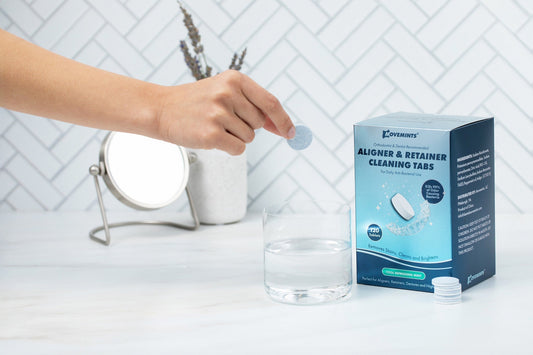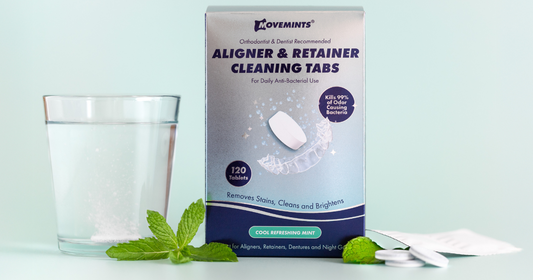Choosing the Best Type of Invisalign Retainer After Treatment
Most people know they’ll have to wear an Invisalign retainer after treatment, but not everyone knows which kind is best for them. Near the end of your smile journey, you’ll have several types of Invisalign retainers to choose from, but not all of them are ideal for invisible aligners. We’ll also introduce two helpful tools — Movemints and Movemints Cleaning Tabs — that can make post-treatment care easier and more effective.
- Most Common Invisalign Retainers
- How Long You’ll Wear Your Invisalign Retainer After Treatment
- Caring for Your Invisalign Retainer
Most Common Invisalign Retainers
There are five basic types of retainers. Three of them are clear retainers, one is the more traditional retainer worn after metal braces, and our final retainer is a newer entrant to the market. Let’s begin with the two most popular types of Invisalign retainers, the Essix retainer and the Vivera retainer.
Essix Retainers
Essix retainers closely resemble the clear aligners you’ve been wearing throughout your treatment. They are made with the same thin, transparent plastic and are very popular because of their durability. Essix retainers cost between $50 to $200 per set, but with proper care they should last between 3 and 5 years.
Certain factors can shorten that duration, such as if you grind your teeth or don’t keep them clean. This can lead to needing a replacement sooner, so take good care of them and if you do grind your teeth, ask your orthodontist if they recommend another type of retainer for your post-treatment needs.

Vivera Retainers
Vivera retainers are simply Invisalign’s branded version of the Essix retainer. Just like when you were fitted for your invisible braces, your orthodontist will take a digital scan of your teeth and have these clear retainers created using the same 3D printing technology that Invisalign uses.
One nice perk of the Vivera retainer is that you’ll get 4 upper and 4 lower retainers, all from the same mold, and all delivered at the same time. This ensures that you’ll have backup retainers on hand, especially useful if you grind your teeth at night or if you travel frequently and want to keep an extra set of Invisalign retainers in your travel bag. However, this does come at a cost, as many providers will charge between $500 and $600 for the Vivera retainer set.
Vivera retainers offer great customer service through Invisalign. If you ever need a new retainer, it’s easy to get one shipped to you because Invisalign saves the digital scan for quick delivery. This is awesome for an Invisalign teen patient or college students who no longer live at home, and noteworthy because traditional retainers require a new impression and subsequent stone model during each fabrication. This requires a trip to the orthodontist’s office, which can be disruptive for anyone with a busy lifestyle or day-to-day obligations like work or school.
The Hawley
The Hawley retainer is an old-school, traditional retainer with acrylic in the middle and a metal wire across the front teeth. It is more common in younger kids after they have an expander. If you’re an adult clear aligner patient, it is unlikely that this would be your type of Invisalign retainer after treatment.

Like the Essix and Vivera retainers, Hawley retainers are removable and durable. They are easy to clean and quite effective, but most Invisalign patients will use either type of clear retainer we described above.
The Fixed Retainer (aka, Permanent Retainer or Lingual Retainer)
Fixed retainers are metal wires glued onto the tongue side of your teeth. These permanent retainers hold in place the teeth to which they are attached. If your lower front teeth were really crooked or crowded in the beginning, these types of Invisalign retainers may be a nice option for you, at least for the first year or two after your treatment. Then you will typically switch to a removable, night-time only retainer like the Essix retainer or Vivera retainer.
If they are so effective, why switch to a removable retainer? The answer is simple: hygiene. Permanent retainers require meticulous care and maintenance. In addition to regular and thorough brushing, they are a bit more challenging to floss. If you don’t floss underneath each part of the wire, then plaque, tartar, and bacteria can build up which can damage your teeth and lead to serious problems like bone loss and gum disease.
Furthermore, while these types of retainers are “permanent” in the sense that they can’t easily be removed like clear Invisalign retainers, they can and will break if you aren’t mindful of what you eat. Not only can a broken retainer require a trip to your orthodontist or provider, it can be difficult to know if it has been broken.
If your fixed retainer breaks without your knowledge, it can go undetected until your next appointment and cause your teeth to relapse, sliding back to their original positions which can only be corrected by costly Invisalign refinements or a whole new treatment plan. If you do need to wear the permanent retainer, consider asking your Orthodontist if you can have an Essix retainer made to fit on top of your permanent retainer to protect it from damage.
The MEMOTAIN® Retainer
The MEMOTAIN® Retainer is a lingual retainer that, like Invisalign’s Vivera retainer, is made from a 3D printer for extreme accuracy. However, the MEMOTAIN® retainer is a lingual retainer that is fixed to the tongue side of your teeth, like a traditional permanent retainer.

Image courtesy of CA Digital, makers of the MEMOTAIN® Retainer
But that’s where the comparisons stop, as these state of the art retainers are very new to market and use a digital design and planning process to tailor them to the precise needs of individual patients. Another claim for the MEMOTAIN® retainer is they are much thinner than conventional lingual retainers. They are made with a special memory alloy that, according to the company’s website, cannot be bent any more once it is brought to shape.
How Long You’ll Wear Your Invisalign Retainer After Treatment
After you complete your Invisalign treatment, your teeth will be in their brand new positions, but they won’t stay that way unless you wear your retainers in accordance with the instructions from your provider.
Many patients ask can retainers move teeth back to their original positions, and the answer is no. Retainers are designed to maintain your smile, and if you don’t wear them as prescribed they will shift out of alignment. This is why most orthodontists recommend you wear a retainer after Invisalign for 22 hours per day for four to six months after your treatment. After that, you’ll likely start to scale back to only at night.
The reality for most patients is that night-time wearing of their retainer becomes a lifelong commitment. In fact, many people choose clear aligners to correct teeth that shifted back after childhood braces as a direct result of retainer non-compliance. After the investment of time and effort you just put into straightening your teeth, make sure you wear your Invisalign retainer exactly as prescribed so you keep that smile just the way you like it for the rest of your life!
Caring for your Invisalign Retainer
As discussed above, Invisalign retainers are an insurance policy to maintain your beautiful new smile. Investing in comfortable retainers and then caring for them properly is part of the smile journey, so factor them into the “total cost of ownership” for your clear aligner treatment.
If you take good care of your Invisalign retainer, you won’t have to spend more than necessary. Learning how to clean Invisalign retainers is an important part of this process. If you choose the Essix retainer or Vivera retainer, clean them as soon as you take them out of your mouth, to rid them of bacteria and debris before it has the chance to harden.
Use lukewarm water and mild dish soap for a more thorough cleaning, or soak them with Movemints Cleaning Tabs. These minty-fresh tablets kill 99% of odor-causing bacteria and remove plaque in just 5 minutes. They’re individually wrapped and compatible with ultrasonic cleaners for deep, daily cleaning.
You can also purchase a retainer cleaner like Smilesaver™ Spray for easy on-the-go cleaning. We are also big fans of the EverSmile® line of retainer cleaning products, which can remove stains from Invisalign trays while whitening your teeth. A great combination!
You can also include Movemints in your daily aligner routine. These sugar-free mints freshen breath, relieve dry mouth, and help seat your retainer for a better fit — all while supporting oral hygiene with xylitol.

How Long Do Clear Retainers Last?
Because retainers cost a lot of money, you may be wondering how long do Invisalign retainers last? The answer is a good six months, but only if you keep them safe from damage or accidental disposal. Purchase a retainer case like this all-in-one option from Capsule Dental that holds your trays, toothpaste and a tooth brush. Or keep it simple with the classic Invisalign retainer case; whichever you choose (and it doesn't hurt to have a few different options), you’ll always have an appropriate place to secure them, whether on your bedside table, purse or travel bag.
Bonus Tip: Store your retainers in a clean case and clean them daily with Movemints Cleaning Tabs to avoid buildup and odors. For on-the-go breath freshening and proper seating, keep Movemints nearby — perfect for your travel case or nightstand.
Regardless of which retainer you choose, daily flossing is crucial to prevent Invisalign gum damage. Removable retainers like the Vivera and Essix take the hassle out of flossing, but it’s still possible to floss with a fixed retainer using a floss threader to get in between and under the fixed retainer wire. Once you get the floss through, follow the classic flossing regime of getting down below the gumline to remove plaque and tartar buildup. Repeat this same process for every tooth that is attached to your permanent retainer.
What To Do If you Lose or Damage Your Invisalign Retainer
This is a common question. Many clear aligner patients save their last set of trays, and in a pinch they can be used as retainers but only for a short period of time. Clear aligners aren't as thick as retainers, so they won’t hold with the same strength and can also wear out faster if you clench your jaw or grind your teeth at night.
If you notice that your retainer is cracked or warped, this is a sign that it’s time to get a replacement. Once they lose their composition, they are no longer as effective at retaining your smile. Continuing to wear a damaged retainer can lead to regression, and no one wants to walk back on their new smile.
You can ask your provider to provide you with a new retainer, but there are also direct-to-consumer retainer companies like SportingSmiles that provide similar quality replacement retainers to what you'll get from your dentist. SportingSmiles will send you their custom impression kit with step-by-step instructions. You ship them back, and they'll send you your new retainers with absolutely no shipping fees. They'll also keep your impressions on file for a year, making future replacements a breeze.

Invisalign retainers are a lifelong part of your smile journey, so plan to ask your orthodontist or provider which retainer would work best for your case. In most cases, patients will find that the Vivera or Essix retainers are appropriate for their needs. Remember: your gums and teeth are a muscle. After training them with clear aligners, you have to retain your results. Anything less would be foolish, and a wasted investment of time and money!
For more Invisalign tips and tricks, check out our Movemints blog to answer every question you have about straightening your teeth with clear aligners — and to learn how Movemints and Movemints Cleaning Tabs can support long-term smile care.




